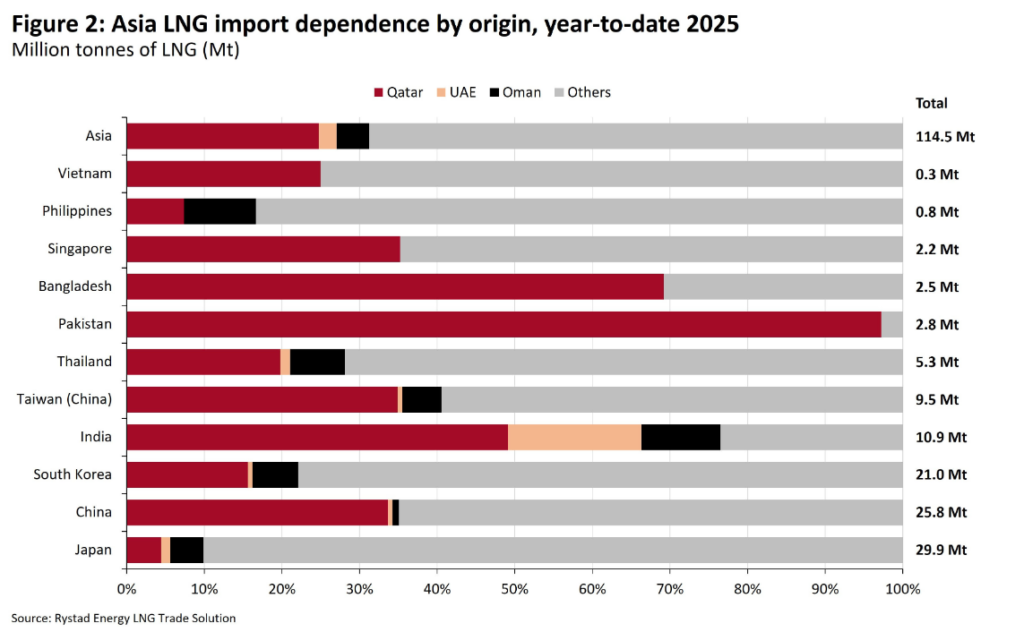
Recent exchanges between Israel and Iran have raised market concerns over potential disruptions to trade flows through the Strait of Hormuz.
Jointly controlled by Iran and Oman, the Strait of Hormuz is a narrow waterway connecting the Persian Gulf to the Gulf of Oman. It serves as the sole maritime passage for vessels traveling between the Persian Gulf and the open ocean.
All Middle Eastern nations stand to benefit from maintaining the open status of the Strait of Hormuz and avoiding any interruptions to supply, according to Rystad Energy.
Mideast countries may avoid closure of Strait of Hormuz
“It’s in the best interest of all Middle Eastern countries to keep the Strait of Hormuz open and prevent any supply disruption,” Lu Ming Pang, senior analyst at Rystad Energy said in an emailed commentary on Wednesday.
While the probability of disruption may be low due to past de-escalations, the severity of a 20% supply disruption would be markedly high, making it prudent to factor in delivery risks from the region.
Regional instability has previously driven price increases, as seen in April 2024, before calming with de-escalation.
Since 2024, vessels have rerouted from the Red Sea and Suez Canal to the Cape of Good Hope, seeking safer passage away from conflict zones.
LNG exports through the Strait of Hormuz
Given that approximately 20% of the world’s liquefied natural gas (LNG) exports traverse the Strait of Hormuz, renewed regional conflict has once again unsettled markets.
Given the potential for significant price increases, especially for nations heavily dependent on LNG from this region, the waterway continues to be closely monitored due to its critical role in trade flows.
For mutual benefit, the US, its allies, and Middle East LNG exporters should ensure the waterway remains open.
Pang said:
This would prevent disruptions to Qatar and UAE LNG exports, which account for 27% of all LNG imports to Asia and 8.5% of all imports to Europe and avert unsustainable price spikes following a supply shock.
Exports of LNG from Qatar and the UAE must transit through the Strait. Due to their cooperative relationship with Iran, both nations will endeavor to ensure that these exports remain unaffected.

Qatar and the UAE exported a total of 83 million tonnes of LNG last year, according to Rystad Energy.
A supply shock of this nature echoes the loss of Russian pipeline flows to Europe during the 2022 invasion of Ukraine.
The event saw 84.2 billion cubic meters (Bcm) of Russian pipeline gas (equivalent to 61.9 million tons of LNG) vanish from the European market, causing prices on the Netherlands-based Title Transfer Facility (TTF) to surge past $70 per million British thermal units (MMBtu).

Prices
On June 13, the day of the Israeli strike on Iran, TTF prices surged by 4.7% in a single day, reaching $12.85 per MMBtu.
During trading on June 16, TTF prices further climbed to $13.42 per MMBtu before closing the day at $12.85 per MMBtu.
Prices have risen by 6.3% to $12.08 per MMBtu, up from early last week on June 9.

By June 16, the East Asia Spot LNG price had climbed to $13.58 per MMBtu, tracking changes in the TTF. This represents an 8.9% increase from $12.46 per MMBtu recorded on June 9.
Analysts at Rystad Energy said:
Emerging warmer summer conditions may be on the minds of East Asian importers, although that has not materialized in too many spot cargo purchases from the region in recent days.
Meanwhile, US Henry Hub prices have shown a slight increase, moving from $3.65 per MMBtu on June 9 to $3.76 per MMBtu on June 17, while largely remaining rangebound.
The post Middle East conflict raises concerns for 20% of global LNG exports appeared first on Invezz

